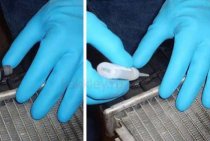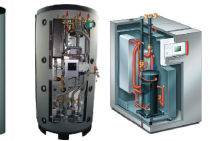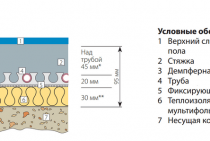Features of the operation of feed pumps
Causes of Feed Pump Failures
Issues of failures of feed pumps in operation and measures to eliminate them become especially acute, since their shutdown entails a significant decrease in the power unit's capacity, and in some cases even its shutdown. The operating experience of pumps shows that most of their faults occur during the start-up period, and most of the failures are observed during the start-up period of the pump.
The most common failures are (in order of frequency):
1) axial force balancing devices;
2) shaft end seals;
3) rotor;
4) hulls;
5) bearings.
The quality of the feed water provided by the water treatment and purification systems of power plants has a significant impact on the performance of the pump and its service life. The task of water treatment is to ensure the necessary water regime, which excludes the occurrence of conditions under which water in certain sections of the steam-water path of power plants acquires aggressive properties.
In specifications, pumps are usually only subject to requirements for the mechanical purity of water and pH. The condition of neutrality of an aqueous solution or water at 25 ° C is determined by the pH value = 7. The pH value of 7 is an alkaline environment.
The pH value of feed water to reduce the rate of erosion of equipment parts of power plants should be in the range of 8.5-9.2. One of the main factors determining the nature and intensity of corrosion of steels is the content of dissolved oxygen in water. The rate of corrosion is also affected by the velocity of the medium, its temperature, and other factors. Deaeration of condensate and feed water has a significant effect on reducing oxygen corrosion of water pumps.
The primary values of these requirements are determined empirically, showing that the most common causes of pump damage are the ingress of foreign metal particles from feed water and condensate into the flow path, causing premature wear of the impeller seals, shaft end seals and other pump elements. This leads to an increase in leakages in the seals and thus to a decrease in the efficiency of the pump, as well as to an increase in the magnitude of the axial force acting on the rotor. The presence of foreign particles in water can also indirectly affect the operating mode of the power unit. So, for example, when starting up a 300 MW unit after installation, due to a large amount of foreign particles on one of the three installed upstream pumps, the protective grids on the inlet side are usually cleaned (the presence of a reserve for upstream pumps makes it possible not to stop and unload this unit).
At power units with a capacity of 500, 800 and 1200 MW, where upstream pumps are part of the units, clogging of the protective grids of upstream pumps can lead to the need to reduce the load of the unit, and possibly to stop it. A considerable amount of time is spent on cleaning the grids, in some cases up to 25-30 hours. All this time, the power unit operates at a reduced load. Thus, metal particles in the water (for example, welding flash, scale, etc.) can affect both the reliability and efficiency of the power unit and can lead to a pump failure (jamming of the flow path, destruction of the hydraulic heel, end shaft seals, etc.).
To prevent the ingress of foreign particles into the pump, it is recommended: to install protective stainless steel screens at the pump inlet (the flow area of the screen should be three to four times the cross-sectional area of the pipeline, the diameter of the holes in the screen frame is 5-10 mm - depending on the value of the flow rate pump); for the period of start-ups after installation or repair, install a fine woven mesh on the mesh frame (the cross section of the fine mesh is assumed to be 0.3-0.4 mm). Before putting the pump into operation after repair and installation, it is necessary to thoroughly clean all inlet and outlet pipelines.
However, the installation of screens and filters cannot completely prevent the smallest solid particles from entering the pump, which can cause great harm when they enter the impeller or shaft seals. Therefore, before putting the pump into operation, in some installations, not only the pipelines are flushed with water, but they are also purged with steam at high speeds or alkalized, and in some cases temporary seals with expanded gaps are installed, etc.
Operation of centrifugal pumps
It is strictly forbidden:
1. Start the electric pump with the suction valve closed, if the internal cavity of the electric pump is not completely filled with the pumped liquid or if there is air, gas, or steam in the internal cavity.
2. Perform the initial start-up of the electric pump after installation or repair without first checking the resistance of the stator winding insulation relative to the housing, which must be at least 1 ohm in a cold state.
3. Operate the electric pump without installing control and blocking devices, as well as in case of damage or loss of rubber rings.
4. Leave the pumped liquid in the switched off electric pump if it can change its state of aggregation at ambient temperature.
Preparing the pump for start-up
Before starting the pump, the operator must check:
cleanliness of the workplace around the pump and the absence of foreign objects near the rotating parts;
serviceability of instrumentation;
the presence and serviceability of the grounding of the starter and the electric motor;
fixing the pump and drive to the foundation;
turning the pump shaft manually, no jamming;
oil level in crankcase
check the serviceability of pipelines for the supply and discharge of barrier fluid by a test run and external inspection.
Pump start.
The pump is started by order of the shift supervisor.
To start the pump you need:
open the suction valve, fill the pump with the pumped liquid, open the top cock (bleeder) on the body, release air (gas) and make sure that the pump is completely filled with liquid;
check the closing of the valve on the discharge pipeline;
turn on the electric motor.
After start-up, the pump operates with a closed valve on the discharge pipeline until the engine reaches the required rotational speed and the pressure in this pipeline becomes equal to the maximum.
Prolonged operation should not be allowed when closed on the pressure pipeline, since this also leads to the evaporation of the liquid. Starting a pump with open discharge fittings can cause shock, resulting in a violation of the control devices and the pump itself.
On the start of the pump, make an entry in the log of the acceptance and delivery of shifts.
Pump operation
During operation, the driver must watch hourly;
normal supply of coolant,
cleanliness and foundation, preventing oil and water from getting on it, as this destroys concrete;
condition and readings of manometers. The operating pressure range should fall on the second third of the pressure gauge scale;
temperature of the pump bearings, not exceeding more than 60?
When operating sealed electric pumps, it is strictly prohibited.
Start the electric pump if it is not sure that it is completely filled with liquid and all air, gas, and steam have been removed from it.
Break the flow of the pumped liquid in the suction line.
Start the electric pump after installation or repair without first checking the insulation resistance of the stator winding relative to the housing.
Start the electric pump with the suction valve closed.
operate the electric pump without installing control and blocking devices specified in the operational documents.
Leave the pumped and coolant switched off at ambient temperature.
Operate the electric pump without cooling it.
The most important condition for the correct operation of the pump is high-quality lubrication of the bearings. It is necessary to monitor the level of the pumped liquid.
When using two pumps (working and standby), you should:
keep the standby pump filled and the valve on the inlet pipe open;
evenly distribute work per cycle or ensure that the backup is switched on at least three times during the overhaul run of the unit.
The driver is obliged to notify the shift supervisor or the foreman of the noticed malfunctions in the operation of the pumps and make an entry in the shift acceptance and delivery log.
The pump must be stopped immediately when:
increase in bearing temperature by 60 °С;
the appearance of extraneous sounds during operation;
electric motor;
unacceptable vibration;
product leakage flange connections;
Pump stop.
The pump is stopped by order of the shift supervisor in the following order:
1. close the valve on the pressure pipeline by switching to the “pull-on” mode of operation;
2. turn off the electric motor by pressing the "Stop" button;
3. shut off the supply of cooling water to the pump housing;
4. close the valve on the pump suction;
5. release the pump from the pumped product, coolant.
6. Report to the shift supervisor and make an entry in the log.


